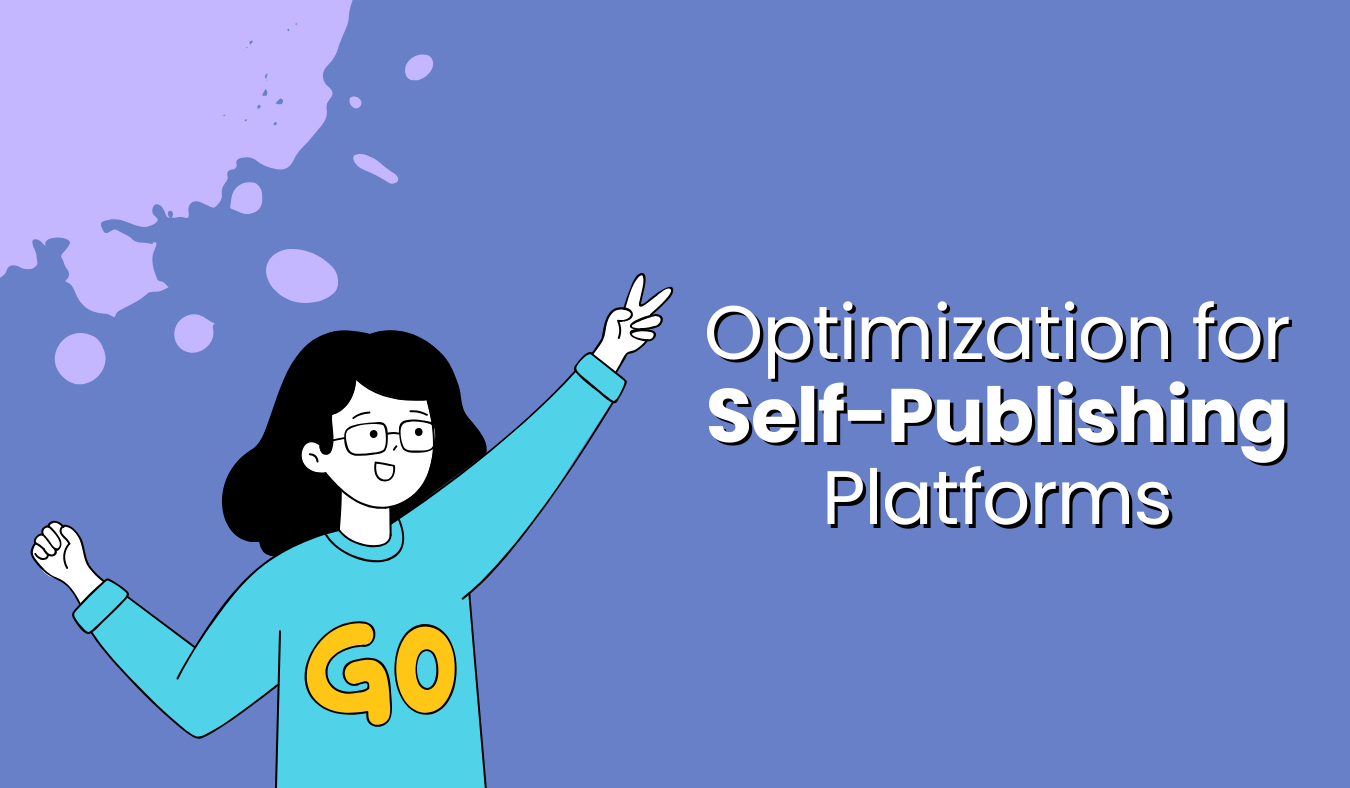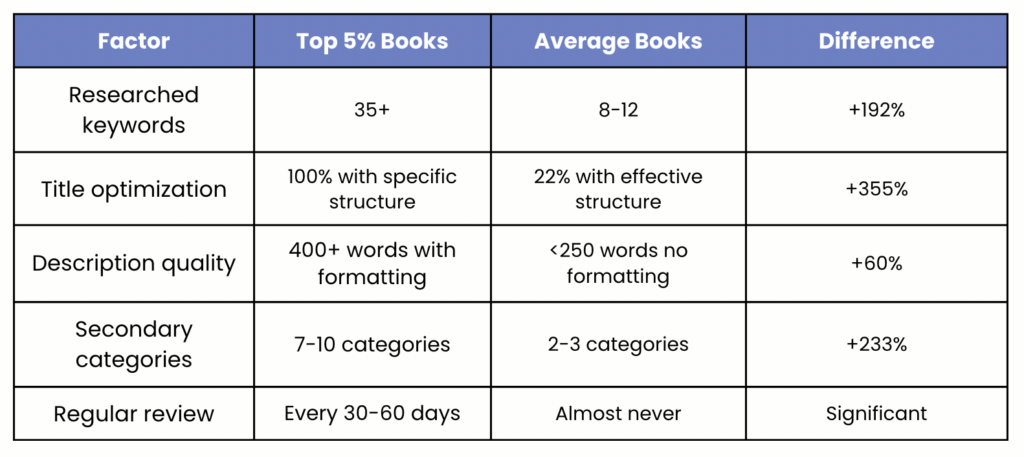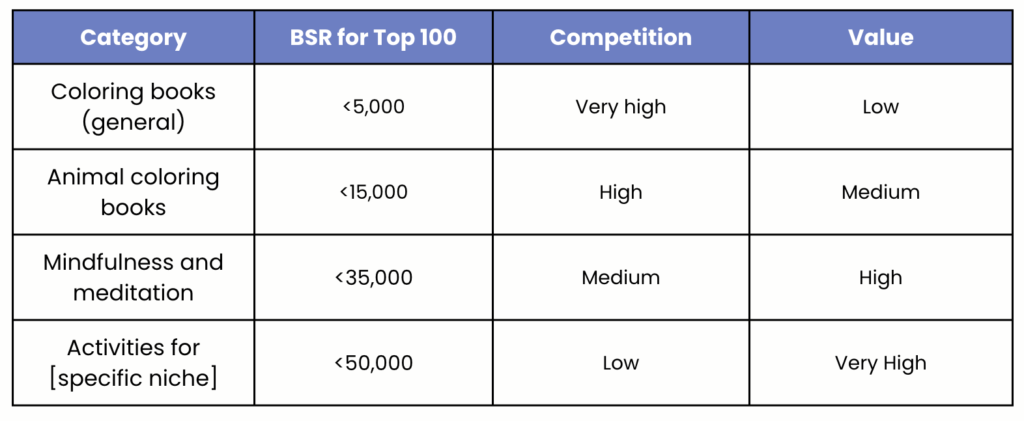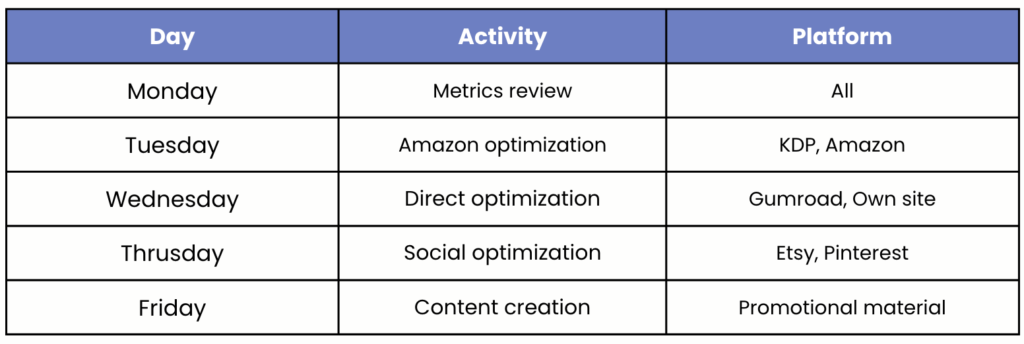How to Optimize Coloring Books for Amazon KDP
Proven Strategies for Self-Publishing Success

If you’re looking to optimize coloring books for Amazon KDP, you’re in the right place. This guide dives into the exact strategies creators use to stand out, increase visibility, and generate reliable income on Amazon and other self-publishing platforms
Table of Contents
Why Optimization Makes a Difference
The reality of the self-publishing market is revealing: according to K-Lytics data, more than 80% of coloring books on Amazon sell less than 10 copies per month. However, the top 5% generates more than 70% of all revenue in the category.
What separates that 5% from the rest? Not necessarily content quality, but strategic optimization.
An analysis of 1,000 coloring book listings revealed:

“The same book can experience a sales difference of up to 320% based solely on listing optimization, without any changes to the actual content.” – Publishing Analytics Study, 2024
Amazon KDP Optimization Fundamentals
1. Ideal title structure for coloring books
Title is your most valuable asset. An optimized title follows this proven formula:
[Main Concept with Keyword]: [Specific Benefit] – [Secondary Description] [Target Audience]
Suboptimized vs. optimized examples:
- ❌ “Mandala Book”
- ✅ “50 Mandalas to Color: Stress Relief and Relaxation – An Adult Coloring Book with Detailed Designs”
Why it works: Incorporates multiple relevant search terms while communicating specific value and attracting the right audience.
2. Strategic keyword research
Keyword research for KDP requires a specific approach:
2.1. Three-tier keyword system:
Tier 1: Main keywords
- High volume (1,000+ monthly searches)
- Direct relevance
- Examples: “adult coloring books”, “mandala coloring”
Tier 2: Niche keywords
- Medium volume (300-1,000 searches)
- Moderate competition
- Examples: “stress relief coloring books”, “detailed coloring books”
Tier 3: Long-tail keywords
- Low volume but high intent
- Low competition
- Examples: “coloring books for anxiety relief”, “complex mandalas to color”
2.2. KDP-specific research tools:
- Publisher Rocket: Amazon-specific search data
- Amazon Autosuggest + Helium 10 combo: To identify real search terms
- Strategic “Also bought” review: Identify patterns in successful listings
Practical strategy: Create a master document with at least 50 relevant keywords before publishing, organized by the three tiers.
3. Description optimization with formatting and sales psychology
The description is where you convert visits into sales. An analysis of 200 successful listings revealed a consistent pattern:
3.1. Proven 4-part structure:
- Initial hook: 1-2 sentences that capture attention and establish the key benefit
- Content details: Specific listing of what’s included (number of designs, features)
- Benefits and use: How and why the book will improve the buyer’s life
- Call to action: Clear instruction to buy now
3.2. Strategic HTML formatting:
Amazon allows limited HTML that few leverage correctly:
- <b>Bold text for key points</b>
- <h2>Subtitles for sections</h2>
- <i>Italic for emphasis</i>
- Bullets for features
Key fact: Descriptions with proper HTML formatting have 38% more dwell time and 27% more conversion than plain text descriptions.
4. Strategic category and subcategory selection
Category selection drastically impacts visibility:
4.1. Main + secondary category strategy:
- Main category: Select the most relevant (not necessarily least competitive)
- Secondary categories (BIC/BISAC): Select maximum possible (up to 10) including some less obvious but relevant
4.2. “Bestseller rank” research by category:

Winning strategy: Combine 2-3 competitive main categories with 4-7 less competitive secondary categories to maximize ranking opportunities.
5. Cover optimization for searches and conversion
The cover fulfills two critical functions that must be balanced:
5.1. Algorithm optimization:
- Cover text: Include 1-2 main keywords
- Visual recognition: Design that Amazon can categorize correctly
- Title consistency: Reinforcement of key terms
5.2. Human conversion optimization:
- Value clarity: Visible in small thumbnails
- Chromatic differentiation: Competitor color palette analysis
- Information hierarchy: Specific order to guide the eye
Advanced technique: Perform A/B testing of covers using Amazon ads with low budget ($30-50) to identify the version with best CTR before finalizing.
Advanced Strategies Few Implement
These strategies separate professionals from the rest:
1. Staggered launch technique
Instead of the typical single launch, elite sellers use a staggered system:
Stage 1: “Silent” launch → Stage 2: Data-based optimization → Stage 3: Relaunch with promotion → Stage 4: Category expansion
Detailed process:
Silent launch (7-10 days):
- Publish with reduced price
- Generate 5-10 initial sales (even to friends/family)
- Collect 2-3 initial reviews
- Analyze keywords generating impressions
Optimization based on first data (day 10-14):
- Adjust title/description based on traffic-generating terms
- Refine categories based on first rankings
- Adjust price to optimal level
Promotional relaunch (day 15-21):
- Implement promotion (countdown deal or limited promotion)
- Activate external marketing
- Actively request more reviews
Category expansion (day 30+):
- Contact KDP support to add additional categories
- Implement secondary keywords based on search patterns
Result: This gradual approach allows the algorithm to “learn” about your book, significantly improving long-term positioning.
2. Staggered review strategy
Reviews are crucial, but their timing and distribution matter more than total quantity:
2.1. Optimal review calendar:
- Week 1: 2-3 detailed reviews (300+ words)
- Week 2-3: 3-5 medium-length reviews (100-200 words)
- Week 4+: Organic reviews supplemented with systematic requests
2.2. Ethical review request system:
- Insert request on last page of book
- Create digital thank you card (QR for review)
- Implement email follow-up system (for digital versions)
Key fact: Listings with 3-5 well-distributed reviews over time outperform listings with 10+ reviews published all at once.
3. Algorithmic update strategy
Elite sellers keep their listings “fresh” for the algorithm through strategic updates:
3.1. Systematic update calendar:
- Every 30 days: Minor description update
- Every 60 days: Keyword review based on data
- Every 90 days: Significant update + notification to Amazon
3.2. Content update technique:
- Addition of 5-10 new pages
- Resolution/quality improvement
- New cover/back cover
- Updated downloadable bonuses
Measured impact: This technique generates an “algorithmic boost” that can increase visibility up to 40-60% for 2-3 weeks after each update.
4. BSR-based dynamic pricing strategy
Instead of static prices, implement a dynamic strategy based on Bestseller Rank:

Implementation: Weekly BSR review with adjustments according to the table. Price adjustments also work as “fresh signals” for the algorithm.
5. Keyword “sandwiching” technique
The most sophisticated sellers use a strategic keyword distribution technique:
5.1. “Sandwich” structure:
- Top layer: Main keywords in title, subtitle, and first 100 characters of description
- Middle layer: Secondary keywords distributed in descriptions and bullet list
- Bottom layer: Long-tail keywords in less visible metadata fields
5.2. Ideal distribution based on analysis of 100 high-performance listings:
- Title: 2-3 main keywords
- KDP keywords field: 7 compound keywords (2-3 word phrases)
- First two bullets: 3-4 keywords each
- Last paragraph of description: 4-5 long-tail keywords naturally integrated
Advanced technique: Combine keywords in natural phrases that include multiple semantic variants.
Optimization for Other Key Platforms
1. Etsy: Optimization for the creative marketplace
Etsy works with a different algorithm that prioritizes:
1.1. Etsy-specific factors:
- Search relevance: More weight on tags than title
- Listing quality: Completeness of all fields
- Shop experience: Clear policies and visual coherence
- Sales history: Recent velocity more important than total volume
- Buyer engagement: Click rate and favorites
1.2. Optimal structure for Etsy:
- Title: 70-120 characters with main keywords at beginning
- Tags: 13 complete tags (don’t waste characters)
- Attributes: Complete 100% (crucial for visibility)
- Description: 3-part system (hook, details, instructions)
- Images: Minimum 5 optimized images (include use mockups)
Etsy-exclusive tactic: Create variations of the same book (digital/physical/bundle) in a single listing to accumulate centralized sales statistics.
2. Gumroad: Optimization for direct sales
Gumroad allows greater control and margins, with different priorities:
2.1. Gumroad optimization factors:
- Psychological pricing: Strategies for prices ending in 7 or 9
- Strategic discounts: Time-limited codes
- Landing page optimization: Proven specific structure
- Email sequences: Follow-up automation
2.2. Winning structure for product pages:
- Title with clear benefit: “Transform your stress into creative calm with…”
- Subtitle with problem-solution: “For busy people who need…”
- Video or animated GIF: Showing book browsing
- 3-5 specific benefit bullets
- Verifiable testimonials (with photos and full names)
- Explicit guarantee (reduces purchase friction)
- Multiple CTAs (beginning, middle and end of page)
Gumroad-exclusive tactic: Create progressive bundles (1 book / 3 books / complete collection) with volume discounts.
3. Pinterest: The underestimated platform for visual books
Pinterest can generate consistent long-term traffic:
3.1. Key optimization factors:
- Strategic pins: 5-7 images per book with different approaches
- Titles with search keywords: Specific research for Pinterest
- Optimized descriptions: 200-300 characters with 2-3 relevant hashtags
- Thematic boards: Strategic organization by niches
- Publishing consistency: 3-5 weekly pins per product
3.2. Most effective pin types for coloring books:
- Cover pin with mockup: Show book in real context
- Interior pages pin: 3-5 high-quality examples
- “Before and after” pin: Blank and colored page
- Instructional pin: “5 benefits of coloring to reduce anxiety”
- Testimonial pin: Customer quote with visually attractive design
Pinterest-exclusive tactic: Create seasonal pins that link to the same product (different approaches by season).
Systems to Scale Your Multi-Platform Presence
To efficiently manage multiple platforms:
1. Efficient cross-posting system
1.1. Optimized workflow:
- Centralized content creation →
- Platform-specific adaptation →
- Scheduled publishing →
- Unified monitoring →
- Data-based optimization
1.2. Recommended tools:
- Central planning: Airtable or ClickUp to manage all listings
- Efficient adaptation: Pre-configured templates by platform
- Publishing: Buffer or Hootsuite for promotional content
- Monitoring: Create single dashboard with Google Data Studio
- Analysis: Weekly review with specific KPIs
2. Continuous optimization calendar
Establish a rotating system to keep all listings fresh:

Documentation system: Maintain a record of changes and results to identify platform-specific patterns.
3. Strategic automation with “if-then” rules
Implement automated rules for optimization:
- If BSR falls below X, then implement Y type promotion
- If CTR is below X%, then update cover
- If conversion rate falls below X%, then review description
- If sales on platform X exceed platform Y, then redistribute efforts
Case Studies: Transformations Through Optimization
Case 1: Marina C. – The power of strategic updating
Marina had published 5 coloring books with mediocre sales (5-8 weekly units per title). She implemented the algorithmic update system:
Specific actions:
- Complete keyword review based on Amazon Marketing Services data
- Description restructuring with optimized HTML formatting
- Quarterly update of each title with 10 additional pages
- Notification to existing buyers about updates
Results: In 90 days, her weekly sales increased to 32-47 units per title, a 487% increase.
“I discovered that for Amazon, a book is not a static product but one that can and should evolve. Every significant update generates a new visibility cycle if communicated correctly.” – Marina C.
Case 2: Carlos F. – Multi-platform mastery with systems
Carlos had an astronomy coloring book with decent sales on Amazon (25-30 monthly). He implemented a multi-platform system:
Specific actions:
- Strategic adaptation of same content for 5 platforms
- Platform-specific optimization (not copy/paste)
- Centralized system for weekly tracking and optimization
- Creation of channel-specific complementary offers
Results: In 60 days, reached combined sales of 220+ monthly units, maintaining Amazon at 35 but adding new revenue channels.
“The same image of a planet can be sold as part of a book on Amazon, as a printable on Etsy, as an asset on Gumroad, and as a pin on Pinterest that leads to my landing page. It’s the same content but specifically optimized for each platform.” – Carlos F.
Case 3: Sofia R. – The staggered launch method
Sofia had traditionally launched her books without strategy, with inconsistent results. For her latest title, she implemented the staggered launch:
Specific actions:
- Silent launch at $7.99 with limited promotion to her email list
- Collection of 8 reviews in the first 12 days
- Keyword optimization based on first traffic data
- “Official” relaunch at $14.99 with external promotion
- Expansion to 8 additional categories through KDP support
Results: The new title sold 145 copies in the first month, compared to an average of 40-50 from her previous launches.
“Treating the launch as a process instead of a single event was revealing. Each stage provided data that informed the next, creating a virtuous cycle of optimization.” – Sofia R.
Conclusion: Optimization as Sustainable Competitive Advantage
Optimization is not a single event but a continuous process. The data clearly shows that:
- Content quality is necessary but not sufficient: The best books can fail without proper optimization
- The advantage is cumulative: Each improvement increases algorithmic visibility, creating a compound effect
- Consistency beats talent: A regular optimization system outperforms sporadic creative efforts
The good news: with tools like Color In AI removing content creation barriers, you can focus your energy on the strategic optimization that really drives sales.
Content is what you sell, but optimization is what determines how much you sell.
Ready to optimize your coloring books for maximum visibility? Try Color In AI free